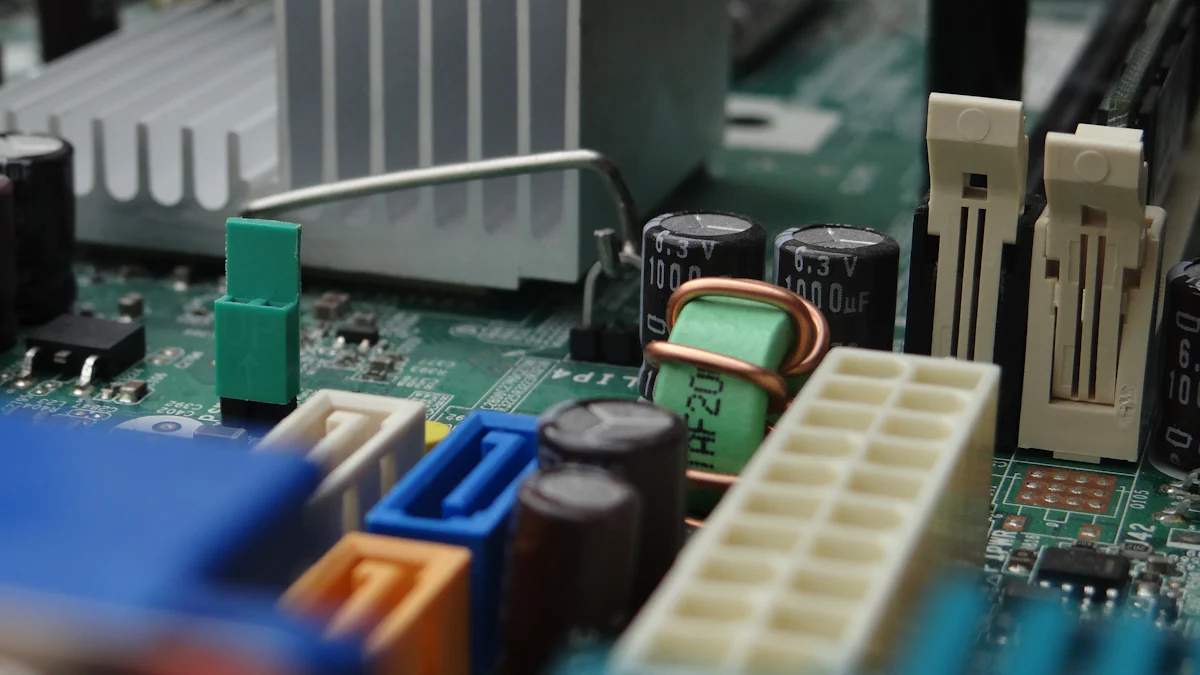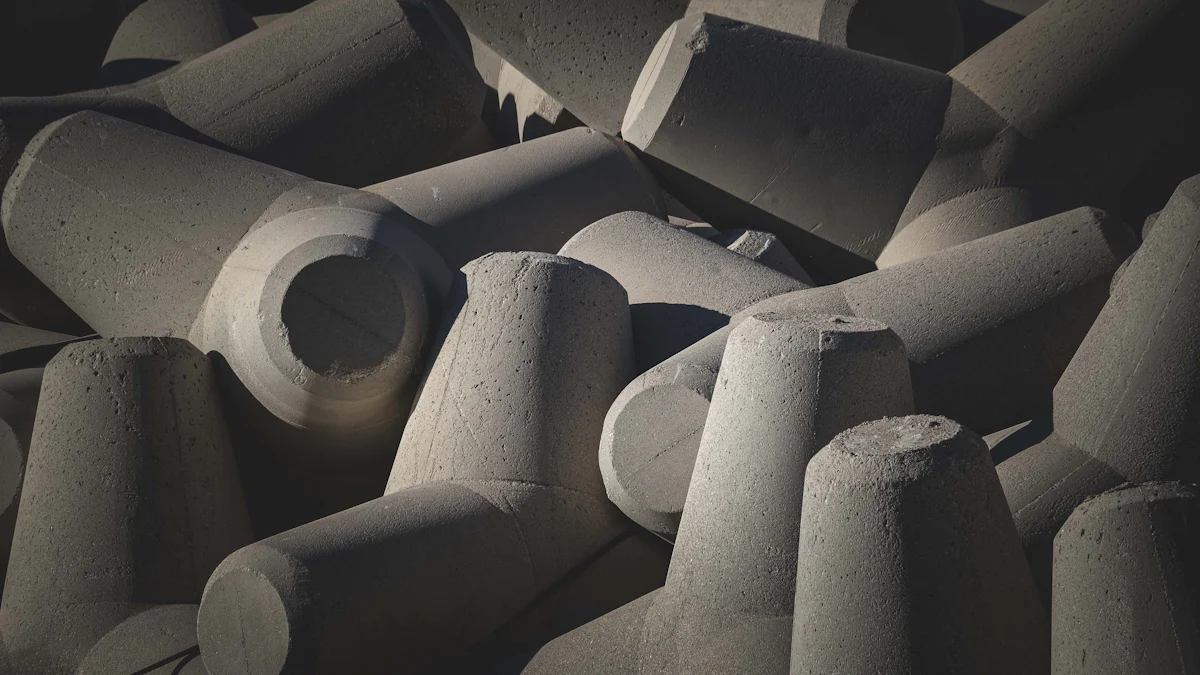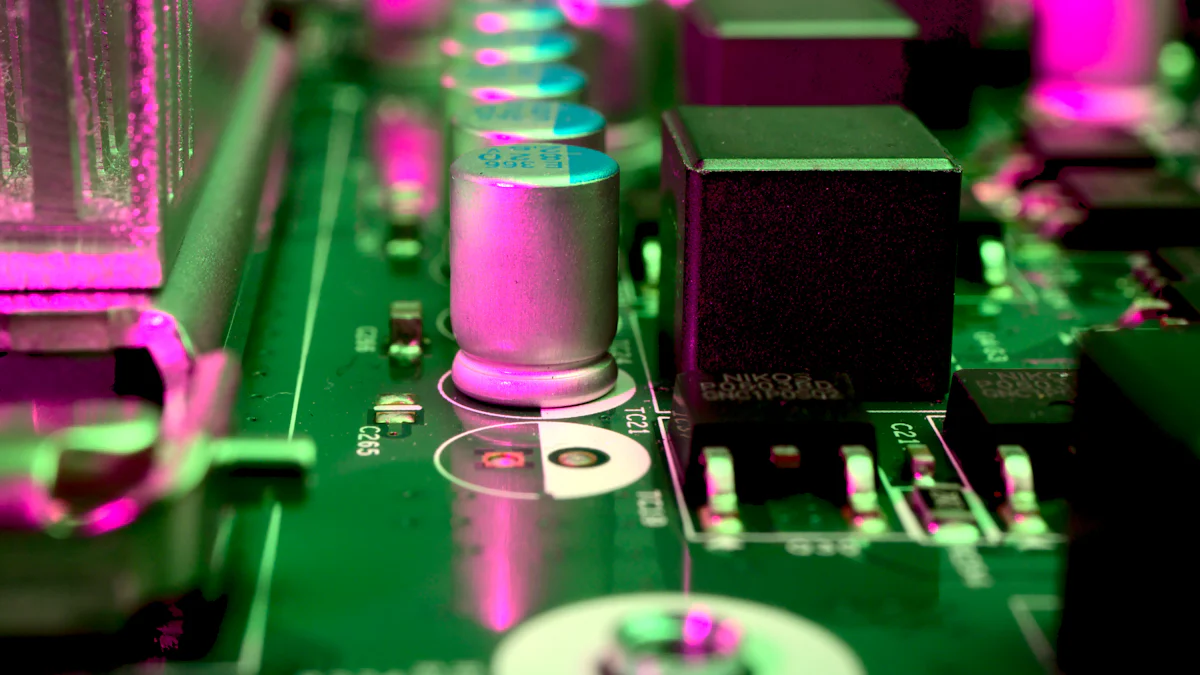
材料の選択はMOCVDの感受性の性能の重要な役割を担います。 素材は、スセプターが熱を分配する方法を決定し、薄膜蒸着時の正確な温度制御を保証します。 高品質の材料は、プロセスガスとの化学反応に抵抗することによって汚染を防止します。 耐久性を高め、極端な条件下での摩耗のリスクを軽減します。 長期にわたる信頼性をサポートし、厳しい用途で一貫した結果を実現します。 適切な材料を優先することにより、メーカーは、優れた効率性とプロセスの完全性を維持することができます.
要点
- 材料の選択は薄膜の沈殿物の間に熱配分および温度制御に直接影響を与えるMOCVDの感受性のために重要です.
- 感受性材料の高い熱伝導性は均一熱を保障しま、欠陥の危険を減らし、フィルムの質を改善します.
- 化学的に安定した材料を選ぶと、汚染を防ぎ、基質の完全性を維持し、薄膜の純度を高めることができます.
- MOCVD装置のための耐久の感受性材料は極端な条件に、摩耗を最小にし、維持費を下げます.
- 適切な材料の優先化は、半導体製造の優れた効率、一貫した結果、そして競争の優位性につながることができます.
- 高品質の素材に投資するだけでなく、製品の品質を向上させるだけでなく、時間をかけて運用コストを削減します.
MOCVDスセプターの役割

MOCVDのスセプターは何ですか?
MOCVDの感受性は金属有機性化学蒸気の沈殿物(MOCVD)プロセスの重要な部品として役立つ。 これらの特殊な構造は、薄膜蒸着時に基質を保持します。 リアクターチャンバー内に配置されたため、基板は高温や制御環境下で安定状態を維持します。 彼らの設計および物質的な構成は直接沈殿物プロセスの効率そして精密に影響を与えます.
受容体の主な機能は、熱を均一に基質に移すことです。 高品質の薄膜を実現するために欠かせない、一貫した温度分布を保証します。 スセプターは障壁として機能し、基質と外部の汚染物質間の不要な相互作用を防ぐ。 安定したクリーンな環境を維持し、欠陥のない層の生産に貢献します.
なぜ材料のプロパティは、スセプターのために不可欠である理由
薄膜蒸着時の補助物質
MOCVDの感受性は沈殿物プロセスの間に基質のための強いサポートを提供しなければなりません。 基質は頻繁に極端な熱および機械的圧力を受けます。 よく設計されたスセプターは、基板の歪みや割れのリスクを最小限に抑えます。 材料は分解なしで高温への延長された露出に抗するために優秀な熱安定性を展示しなければなりません.
素材選定は、各種基板タイプによるスセプターの適合性にも影響します。 例えば、特定の材料は特定の基質かガスと、汚染か欠陥に導く反応するかもしれません。 適切な材料を選ぶと、基板の完全性が確保され、堆積した薄膜の全体的な品質が向上します.
均一暖房および温度制御の達成
均一加熱はMOCVDプロセスの角質です。 スセプターは、基板表面全体に熱を均等に分配するピボタル役割を果たします。 不均等な暖房は温度の勾配を、非均一なフィルムの厚さか悪い水晶質のような欠陥をもたらすことができます。 感受性材料の高い熱伝導性は有効な熱伝達を保障しま、これらの問題の可能性を減らします.
精密な温度制御は等しく重要です。 受容体材料は、温度の変化を予測可能に反応し、オペレータがプロセス全体で最適な条件を維持できるようにしなければなりません。 熱膨張係数の低い材料は、歪みを最小限に抑え、さまざまな熱負荷の下で一貫した性能を維持するため、理想的です.
考慮する主要な物質的な特性
熱伝導性
MOCVDプロセスにおける熱分布の重要性
熱伝導性はMOCVDの感受性の性能で重要な役割を担います。 熱伝導率の高い材料は基質の表面を渡る有効な熱伝達を保障します。 このプロパティは、スセプターが熱を均等に分配することを可能にします。これは、薄膜堆積の間に一貫した温度を維持するために不可欠です。 均一熱配分は直接沈殿物の層の質に影響を与えます、欠陥の危険を減らし、フィルムの厚さの精密な制御を保障します.
MOCVDプロセスでは、温度の均等性は、高品質のエピタキシャル成長を達成するために重要です。 熱伝導率の悪い受容体材料は局所化された熱か風邪の点を作成できます。 これらの矛盾は不均等な沈着率に導き、薄膜の構造的完全性を妥協します。 優れた熱伝導性を持つ材料を選択すると、最適な熱管理が保証され、プロセスの全体的な効率が向上します.
温度の勾配および欠陥を避けて下さい
受容体内の温度勾配は、堆積中に重要な問題を引き起こす可能性があります。 基質の表面を渡る温度の変化は頻繁に非ユニフォームの水晶成長か圧力誘発された割れるのような欠陥をもたらします。 これらの欠陥は最終的なプロダクトの性能そして信頼性を減らします。 高品質の感受性材料は、温度の勾配を最小限に抑え、基板の安定した熱環境を保証します.
熱膨張係数の低い材料は更に温度制御を高めます。 熱応力下での歪みに抵抗し、高温でも構造的完全性を維持します。 この安定性により、オペレータは一貫した結果を達成し、欠陥の可能性を減らし、MOCVDプロセスの歩留まりを改善することができます.
化学安定性
腐食および化学反応への抵抗
化学的安定性はMOCVDの感受性のための別の重要な特性です。 材料はプロセスガスへの露出によって引き起こされる腐食および化学反応に抵抗しなければなりません。 反応材料は反応器室に汚染物質を解放する時間をかけて分解できます。 これらの汚染物質は薄膜の純度を妥協し、最終製品の性能に影響を与える欠陥を紹介します.
化学的に安定した感受性材料はプロセス ガスの広い範囲との両立性を保障します。 それは粗い条件の下で完全性を維持し、薄膜の沈殿物のためのきれいで、制御された環境を提供します。 化学劣化に対するこの抵抗は、感受性の寿命を延ばし、維持要件を削減し、MOCVDプロセスの全体的な効率性に貢献します.
サブストレーツの汚染を防ぐ
汚染は薄膜の沈着の間に重要な危険を保ちます。 感受性材料によって導入された不純物は薄膜の化学成分を変えることができます、欠陥および減らされた性能に導きます。 化学的に安定した材料は、プロセスガスとの反応に抵抗し、きれいな表面を維持することによって、これらの問題を防ぎます.
炭化ケイ素か水晶のような高純度材料は、優秀な化学安定性のために頻繁に好まれます。 これらの材料は汚染の危険を最小限にし、高品質の薄膜の生産を保証します。 化学的に安定した感受性材料を選ぶことによって、製造業者は優秀な結果を達成し、プロセスの完全性を維持できます.
Mechanical Strength
高温および圧力の理解
MOCVDの感受性は高温および機械圧力を含む極度な条件の下で、作動します。 材料は変形するか、または壊すことなしでこれらの挑戦に抗するために例外的な機械強さを展示しなければなりません。 耐久の感受性材料は高い熱への延長された露出の下の沈殿物プロセスを通して信頼できる性能を、保障します.
機械的強度は、蒸着中に基材を支持する感受性の能力にも影響します。 弱い材料は熱応力の下で警戒するか、またはひび割れ、基質の安定性を妥協するかもしれません。 堅牢な材料を選択すると、MOCVDプロセスの信頼性を高め、機器の故障のリスクを軽減します.
長寿と信頼性の確保
MOCVDの感受性の長寿は摩耗に抵抗し、時間をかけて分解する能力に依存します。 高い機械的強度を持つ材料は、繰り返し熱循環の下で構造的整合性を維持し、複数の堆積の実行に一貫した性能を保証します。 頻繁な交換の必要性を減らし、維持費を下げ、プロセス効率を改善します.
MOCVDプロセスの全体的な安定性に信頼できる感受性は寄与します。 優れた機械的特性を持つ材料を選択することにより、メーカーは長期的信頼性を達成し、高い生産基準を維持することができます。 耐久性に焦点を合わせ、一貫した結果が得られ、先進の薄膜技術の開発をサポートします.
貧しい材料の選択の結果
サブストレーツの汚染
MOCVDの感受性のための貧しい材料の選択は頻繁に基質汚染につながります。 低い化学安定性の材料はプロセスガスと反応し、原子炉の部屋に不純物を解放するかもしれません。 これらの不純物は薄膜の化学組成を変え、基質表面に解決します。 汚染されたフィルムは、矛盾した厚さ、悪い付着、または妥協された電気的特性のような欠陥を展示します.
汚染物質は、最終製品の性能に直接影響します。 たとえば、半導体アプリケーションでは、マイクロチップやLEDの機能を破壊するマイナーな不純物さえあります。 製造業者は、廃棄物の増加と生産コストの増加につながる欠陥のある製品を捨てなければなりません。 化学的に安定した感受性材料の選択は汚染の危険を最小にし、良質の薄膜の生産を保障します.
プロセス効率を削減
非効率的な熱伝達は、下流感受性材料を使用する一般的な結果です。 熱伝導率の悪い材料は基質を渡る熱を均等に配ることができません。 この不均等な暖房は温度の勾配を作り出します、それは非均一沈殿物率および矛盾したフィルムの質をもたらします。 オペレータは、プロセスパラメータを頻繁に調整し、これらの問題に対して補償する必要がある場合があり、全体的な効率性を削減します.
また、機械的強度の不十分なスセプターは、熱応力下で変形することがあります。 歪んだり、割れた感受性器は、基板の安定性を混乱させ、堆積プロセスの遅延や中断を引き起こします。 これらの非効率性は、サイクルタイムを増加させ、スループットを減らし、最終的にMOCVD操作の収益性に影響を与えます。 優秀な熱および機械特性の高性能材料はプロセス効率を維持し、一貫した結果を保障します助けます.
装置の摩耗および維持費の増加
高品質の感受性材料は、機器の摩耗を加速し、メンテナンス要件を増加させます。 化学的に不安定な材料は、原子炉チャンバー内で蓄積する粒子を解放し、時間をかけて劣化します。 これらの粒子は、ガスインジェクタや加熱要素などの敏感なコンポーネントを損傷し、頻繁な修理や交換につながる.
機械的故障により、メンテナンスコストが高まります。 繰り返された熱循環に耐えられないスセプターは、交換のための生産を中止するためにオペレータを必要とする割れたり、壊れたりすることがあります。 頻繁なダウンタイムはワークフローを混乱させるだけでなく、運用費用も増加させる。 耐久性、高品質のスセプター材料に投資することで、摩耗や涙を減らし、機器の寿命を延ばし、長期的なメンテナンスコストを削減します.
「貧しい材料の選択のコストは、受容体自体を超えて拡張します。 業界の専門家が指摘したように、基板の品質から機器の信頼性に至るまで、MOCVDプロセス全体に影響を与えます。 適切な材料を優先して、よりスムーズな操作とより良い結果を保証します.
共通材料とその応用例

Graphite
高温度アプリケーションの利点
グラナイトは、高温環境での優れた性能のために、MOCVDの感受性者のための人気のある選択肢として際立っています。 構造の完全性を失うことなく極端な熱に耐える能力は、要求の厳しい堆積プロセスに最適です。 材料の高い熱伝導性は基質を渡る均一温度の配分を促進する有効な熱伝達を保障します。 このプロパティは、一貫した薄膜堆積を達成し、エピタキシャル層の品質を維持するために不可欠です.
グラファイトはまた優秀な切削加工性を提供し、製造業者は特定の原子炉の設計に会うためにsusceptorsをカスタマイズすることを可能にします。 軽量化により、機械的ストレスを軽減し、作業効率を高めます。 これらの特性は、激しい熱条件下で精度と耐久性を必要とするアプリケーションのための信頼性の高いオプションをグラファイトにします.
化学安定性の限界
その利点にもかかわらず、グラファイトは化学安定性に著しい制限を持っています。 材料は一定したプロセス ガスと、時間上の表面の低下に導く反応します。 原子炉チャンバーに不純物を解放し、基質汚染の危険性を高めることができます。 そのような汚染は薄膜の品質を妥協し、最終製品の性能に影響を与える欠陥を引き起こす可能性があります.
この問題に対処するため、メーカーはしばしばシリコンカーバイドなどの保護層でグラファイトスセプターをコートします。 これらのコーティングは化学抵抗を高め、susceptorの寿命を拡張します。 しかし、追加のコーティングプロセスは、生産コストを増加させ、全体的な予算の検討に影響を与える可能性があります.
Silicon Carbide (SiC)
優れた熱伝導性と耐久性
シリコンカーバイド(SiC)は、優れた熱伝導性と比類のない耐久性により、MOCVDスセプターに最適な材料です。 熱を効率的に移す能力は、高品質の薄膜蒸着のために不可欠である均一温度制御を保証します。 SiCの熱特性は温度の勾配を最小にし、不均等なフィルムの厚さまたは水晶欠陥のような欠陥の可能性を減らします.
素材の優れた硬度と耐摩耗性により、さらなる魅力を高めます。 SiCは、高温および機械的ストレスへの長期暴露の下で構造的完全性を維持します。 この耐久性は、MOCVDプロセスにおける長期的信頼性を求めるメーカーにとって費用対効果の高い選択肢となります.
高精度アプリケーションに最適
SiCは、精度と一貫性がパラマウントされる高精度なアプリケーションで優れています。 低い熱膨張係数は熱応力の下で最低の歪みを、沈殿物の間に基質の精密な直線保障します保障します。 この安定性は、先進半導体および光電子デバイスにとって重要な欠陥のない層の生産をサポートしています.
また、SiCの化学的安定性は、プロセスガスによる不要な反応を防ぎ、リアクターチャンバー内のクリーンな環境を保証します。 MOCVDプロセスの全体的な効率を高め、汚染の危険性を減らします。 厳しい基準を要求する業界にとって、SiCは性能と信頼性の最適なバランスを提供します.
高純度石英
優れた化学安定性と透明性
高い純度の水晶は顕著な化学安定性のために有名で、それ特定の適用のMOCVDの感受性のための優秀な選択をします。 積極的なプロセスガスにさらされても、材料は腐食および化学反応に抵抗します。 この安定性は、汚染のない環境を確保し、薄膜の純度を維持し、最終製品の品質を向上させる.
水晶はまた独特な光学透明物を所有しています、それを可能にしま効果的にライトを送信します。 この特性は精密な光学監視か制御を要求するプロセスで特に貴重です。 高温下での明瞭性を維持し、専門用途の適合性を高めます.
特定の光学適用のために適した
水晶の透明性と耐薬品性は、発光ダイオード(LED)などの光学用途に理想的です。 さまざまな蒸着技術との互換性により、複雑な製造工程でも一貫した結果が得られます。 素材の熱安定性は、高品質のエピタキシャル成長を達成するために不可欠である均一加熱をサポートしています.
しかし、SiCなどの材料と比較して、水晶は機械的強度に制限されています。 極端な熱循環や機械的ストレス下でも実行できません。 それにもかかわらず、そのユニークな特性は、化学的純度と光学性能が優先する用途に不可欠です.
MOCVDの感受性のための材料の選択は薄膜の沈殿物プロセスの成功を決定します。 高品質の材料は、均一な加熱を保証します。これにより、フィルムの一貫性を高め、欠陥を減らすことができます。 化学的に安定した選択は汚染を防ぎ、基質の完全性を保護します。 耐久材料は摩耗を最小にし、維持費を下げ、装置の寿命を延長します。 半導体業界の専門家は、性能を最適化し、競争上の優位性を維持するために材料の選択を優先しなければなりません。 適切な感受性材料を選ぶことによって、製造業者は優秀な効率を達成し、プロダクト質を改善し、運用費を削減できます.